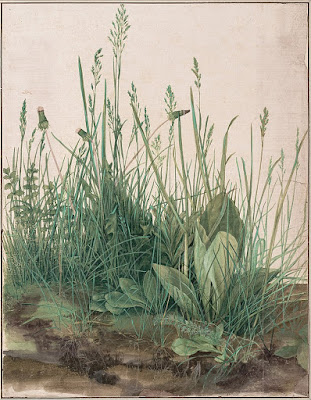It can be either deliciously finicky, or wildly out of control. Or, in a perfect world, both.
|
St. Elias Mountains, Yukon Territory, by Carol L. Douglas. Think you can’t paint from a boat? This was done from the passenger seat of a car. |
Yesterday I got an e-blog that read, “Want looser watercolors? Pour your paint.” Well, I like pitching, throwing and otherwise making a mess with watercolors, so I opened it in great anticipation. What it was really talking about was drawing a meticulous cartoon, blocking off the light areas with masking fluid, and then setting the darks with a wallowing, graduated wash that gets a little bit psychedelic by virtue of watercolor’s great sedimentation qualities.
That’s a beautiful technique, but nothing that starts with masking fluid can be described as loose. We can’t use these shadowy washes in field painting, unless we’re willing to hang around all day reblocking paper and waiting for it to dry.
 |
| A field sketch of Houghton Farm (New York) by Winslow Homer. |
Watercolor is a curious medium. It’s quite capable of the ultimate control, as in Albrecht Dürer’s Large Piece of Turf, 1503. It’s equally capable of insouciance, as in Maurice Prendergast’suntitled seascape, below. You can go anywhere you want with it.
 |
| Untitled seascape by Maurice Prendergast. |
Frank Costantino is a painter who manages to pull off meticulous renderings in watercolor in plein air events. Frank’s drawings are spot-on and his framing is clever. On the other end of the spectrum is Elissa Gore, whose field sketches always burble in the style of Ludwig Bemelmans.
You know my pal Poppy Balser, who shares my adoration of boats, the sea, and color. Although she’s primarily an oil painter, Mary Byrom does lots of sketching in watercolor.
 |
|
Large Piece of Turf, 1503, Albrecht Dürer.
|
There hangs the moral of my tale. Every one of these painters works in more than one medium—in Frank’s case, watercolor and colored pencil, in the rest of them, watercolor and oils. That’s true of me, too.
I first learned to paint in watercolor. That was standard procedure in the mid-century, when no right-minded teacher was going to hand a kid a box of toxic chemicals and tell her to go to town. It’s a private possession for when I travel or when I’m thinking. I never sell my watercolors, and I don’t intend for them to be shown. Watercolor, for me, is deeply personal.
 |
| Preparatory sketch of Marshall Point, by Carol L. Douglas. |
But it’s also the perfect travel medium, which is why I took it to Australia and to London and plan to bring it along to Alabama, Louisiana and Mississippi in March. When it’s just you, your suitcase and a Prius, you want to travel light.
All of this has been much on my mind recently as I’ve debated the best sketchbooks to buy for my Age of Sail workshop on the American Eagle, in June. I’ve tried many myself. As with everything else, each one has its plusses and minuses. One friend suggested that I cut down sheets of paper and make my own, but I want every student to have a takeaway book with a nice binding.
I plan to have students working in both gouache and watercolor. I need to find the right paper for both. So every time a friend posts a new work in a sketchbook I query him or her relentlessly on the materials. And I’m narrowing it down, slowly but surely.
